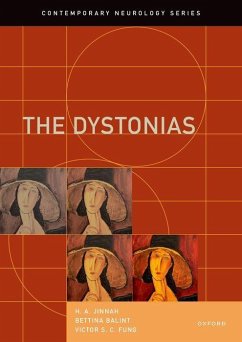Cohen
Press Freedom and the Crooked Path Toward Democracy
Cohen
Press Freedom and the Crooked Path Toward Democracy
- Gebundenes Buch
- Merkliste
- Auf die Merkliste
- Bewerten Bewerten
- Teilen
- Produkt teilen
- Produkterinnerung
- Produkterinnerung
The Dystonias provides a comprehensive practical clinical resource that addresses how to recognize the many types of this unusual type of movement disorder, dystonias, and how they are diagnosed and evaluated, and explores the currently available medical and surgical treatments.
Andere Kunden interessierten sich auch für
![A Path to Freedom in the School A Path to Freedom in the School]() Norman Mac MunnA Path to Freedom in the School35,99 €
Norman Mac MunnA Path to Freedom in the School35,99 €![Teaching Toward Freedom Teaching Toward Freedom]() William AyersTeaching Toward Freedom18,99 €
William AyersTeaching Toward Freedom18,99 €![Transforming the Path to Achieve India's SDGs Transforming the Path to Achieve India's SDGs]() Rahul K.Transforming the Path to Achieve India's SDGs12,99 €
Rahul K.Transforming the Path to Achieve India's SDGs12,99 €![THE PATH TO HAPPINESS THE PATH TO HAPPINESS]() Abd Ar-Rahman Bin Ash-ShehaTHE PATH TO HAPPINESS25,99 €
Abd Ar-Rahman Bin Ash-ShehaTHE PATH TO HAPPINESS25,99 €![Navigating the Path to College Navigating the Path to College]() Solomon SahleNavigating the Path to College43,99 €
Solomon SahleNavigating the Path to College43,99 €![The Path of Speech Technologies in Computer Assisted Language Learning The Path of Speech Technologies in Computer Assisted Language Learning]() Pete F. Fisher / Melissa Holland (eds.)The Path of Speech Technologies in Computer Assisted Language Learning210,99 €
Pete F. Fisher / Melissa Holland (eds.)The Path of Speech Technologies in Computer Assisted Language Learning210,99 €![The Prison Path The Prison Path]() Christen E ClemsonThe Prison Path101,99 €
Christen E ClemsonThe Prison Path101,99 €-
-
-
The Dystonias provides a comprehensive practical clinical resource that addresses how to recognize the many types of this unusual type of movement disorder, dystonias, and how they are diagnosed and evaluated, and explores the currently available medical and surgical treatments.
Hinweis: Dieser Artikel kann nur an eine deutsche Lieferadresse ausgeliefert werden.
Hinweis: Dieser Artikel kann nur an eine deutsche Lieferadresse ausgeliefert werden.
Produktdetails
- Produktdetails
- Verlag: Oxford University Press, USA
- Erscheinungstermin: 26. Juli 2023
- Englisch
- ISBN-13: 9780197631966
- ISBN-10: 0197631967
- Artikelnr.: 71236023
- Herstellerkennzeichnung
- Libri GmbH
- Europaallee 1
- 36244 Bad Hersfeld
- gpsr@libri.de
- Verlag: Oxford University Press, USA
- Erscheinungstermin: 26. Juli 2023
- Englisch
- ISBN-13: 9780197631966
- ISBN-10: 0197631967
- Artikelnr.: 71236023
- Herstellerkennzeichnung
- Libri GmbH
- Europaallee 1
- 36244 Bad Hersfeld
- gpsr@libri.de
H.A. Jinnah got his MD degree and a PhD degree in Neuroscience from the University of California in San Diego. He then completed a Neurology Residency at Johns Hopkins University in Baltimore, and was on the faculty there for 10 years. Since 2009 he has been at Emory University in Atlanta, where he is Professor of Neurology, Human Genetics, and Pediatrics. He has more than 300 publications, with a special interest in research relating to dystonia, neurogenetics, and the development of novel treatments. Bettina Balint is assistant professor for clinical research on complex movement disorders and Parkinson¿s disease at the University of Zurich, and head of the movement disorder department at the University Hospital Zurich. Her clinical and academic career in neurology comprised specialist training in movement disorders and autoimmune diseases at the University Hospital Heidelberg, Germany, the UCL Queen Square Institute of Neurology, London, and the neuroimmunology department of the University of Oxford, UK. She has numerous publications including peer-reviewed journal articles, book chapters and books, serves on various guideline committees, task forces, editorial boards and regularly lecture at various national and international meetings. Victor Fung is Professor of Neurology and Motor Control, Sydney Medical School, The University of Sydney, and Director of the Movement Disorders Unit and past Head, Department of Neurology, Westmead Hospital in Sydney, Australia. He is President of the International Parkinson and Movement Disorder Society (MDS) and a past-President of the Movement Disorder Society of Australia and New Zealand. He has a clinical and research interest in Parkinson's disease and movement disorders with over 200 peer-reviewed publications and an h-index of 57.
* Chapter 1: A brief history of the concept of dystonia and its
evolution
* Chapter 2: The defining clinical features of dystonia
* Chapter 3: Classification and diagnostic strategy for dystonia
* Chapter 4: Epidemiology of the dystonias
* Chapter 5: Cervical dystonias
* Chapter 6: Craniofacial dystonias
* Chapter 7: Laryngeal dystonias
* Chapter 8: Limb dystonias
* Chapter 9: Isolated generalized dystonias
* Chapter 10: Musician's and other task-specific dystonias
* Chapter 11: Non-motor features of dystonia
* Chapter 12: Dystonia and tremor
* Chapter 13: Dystonia and parkinsonism
* Chapter 14: Dystonia and ataxia
* Chapter 15: Dystonia and myoclonus
* Chapter 16: Dystonia and cerebral palsy
* Chapter 17: Dystonia and the paroxysmal dyskinesias
* Chapter 18: Dystonias combined with other features
* Chapter 19: Dystonia induced by medications, illicit drugs, and
environmental toxins
* Chapter 20: Dystonia and trauma
* Chapter 21: Dystonia and autoimmunity
* Chapter 22: Dystonia genetics
* Chapter 23: The neuroanatomical substrates of dystonia
* Chapter 24: Dystonia physiology
* Chapter 25: Psychogenic (functional) dystonia
* Chapter 26: Pseudodystonia and differential diagnosis
* Chapter 27: Workup of dystonia
* Chapter 28: Symptom-targeted oral medications for dystonia
* Chapter 29: Special interventions for certain types of dystonia
* Chapter 30: Botulinum toxin treatment for dystonia
* Chapter 31: Surgical treatments for dystonia
* Chapter 32: Physiotherapy and complementary medicine for dystonia
evolution
* Chapter 2: The defining clinical features of dystonia
* Chapter 3: Classification and diagnostic strategy for dystonia
* Chapter 4: Epidemiology of the dystonias
* Chapter 5: Cervical dystonias
* Chapter 6: Craniofacial dystonias
* Chapter 7: Laryngeal dystonias
* Chapter 8: Limb dystonias
* Chapter 9: Isolated generalized dystonias
* Chapter 10: Musician's and other task-specific dystonias
* Chapter 11: Non-motor features of dystonia
* Chapter 12: Dystonia and tremor
* Chapter 13: Dystonia and parkinsonism
* Chapter 14: Dystonia and ataxia
* Chapter 15: Dystonia and myoclonus
* Chapter 16: Dystonia and cerebral palsy
* Chapter 17: Dystonia and the paroxysmal dyskinesias
* Chapter 18: Dystonias combined with other features
* Chapter 19: Dystonia induced by medications, illicit drugs, and
environmental toxins
* Chapter 20: Dystonia and trauma
* Chapter 21: Dystonia and autoimmunity
* Chapter 22: Dystonia genetics
* Chapter 23: The neuroanatomical substrates of dystonia
* Chapter 24: Dystonia physiology
* Chapter 25: Psychogenic (functional) dystonia
* Chapter 26: Pseudodystonia and differential diagnosis
* Chapter 27: Workup of dystonia
* Chapter 28: Symptom-targeted oral medications for dystonia
* Chapter 29: Special interventions for certain types of dystonia
* Chapter 30: Botulinum toxin treatment for dystonia
* Chapter 31: Surgical treatments for dystonia
* Chapter 32: Physiotherapy and complementary medicine for dystonia
* Chapter 1: A brief history of the concept of dystonia and its
evolution
* Chapter 2: The defining clinical features of dystonia
* Chapter 3: Classification and diagnostic strategy for dystonia
* Chapter 4: Epidemiology of the dystonias
* Chapter 5: Cervical dystonias
* Chapter 6: Craniofacial dystonias
* Chapter 7: Laryngeal dystonias
* Chapter 8: Limb dystonias
* Chapter 9: Isolated generalized dystonias
* Chapter 10: Musician's and other task-specific dystonias
* Chapter 11: Non-motor features of dystonia
* Chapter 12: Dystonia and tremor
* Chapter 13: Dystonia and parkinsonism
* Chapter 14: Dystonia and ataxia
* Chapter 15: Dystonia and myoclonus
* Chapter 16: Dystonia and cerebral palsy
* Chapter 17: Dystonia and the paroxysmal dyskinesias
* Chapter 18: Dystonias combined with other features
* Chapter 19: Dystonia induced by medications, illicit drugs, and
environmental toxins
* Chapter 20: Dystonia and trauma
* Chapter 21: Dystonia and autoimmunity
* Chapter 22: Dystonia genetics
* Chapter 23: The neuroanatomical substrates of dystonia
* Chapter 24: Dystonia physiology
* Chapter 25: Psychogenic (functional) dystonia
* Chapter 26: Pseudodystonia and differential diagnosis
* Chapter 27: Workup of dystonia
* Chapter 28: Symptom-targeted oral medications for dystonia
* Chapter 29: Special interventions for certain types of dystonia
* Chapter 30: Botulinum toxin treatment for dystonia
* Chapter 31: Surgical treatments for dystonia
* Chapter 32: Physiotherapy and complementary medicine for dystonia
evolution
* Chapter 2: The defining clinical features of dystonia
* Chapter 3: Classification and diagnostic strategy for dystonia
* Chapter 4: Epidemiology of the dystonias
* Chapter 5: Cervical dystonias
* Chapter 6: Craniofacial dystonias
* Chapter 7: Laryngeal dystonias
* Chapter 8: Limb dystonias
* Chapter 9: Isolated generalized dystonias
* Chapter 10: Musician's and other task-specific dystonias
* Chapter 11: Non-motor features of dystonia
* Chapter 12: Dystonia and tremor
* Chapter 13: Dystonia and parkinsonism
* Chapter 14: Dystonia and ataxia
* Chapter 15: Dystonia and myoclonus
* Chapter 16: Dystonia and cerebral palsy
* Chapter 17: Dystonia and the paroxysmal dyskinesias
* Chapter 18: Dystonias combined with other features
* Chapter 19: Dystonia induced by medications, illicit drugs, and
environmental toxins
* Chapter 20: Dystonia and trauma
* Chapter 21: Dystonia and autoimmunity
* Chapter 22: Dystonia genetics
* Chapter 23: The neuroanatomical substrates of dystonia
* Chapter 24: Dystonia physiology
* Chapter 25: Psychogenic (functional) dystonia
* Chapter 26: Pseudodystonia and differential diagnosis
* Chapter 27: Workup of dystonia
* Chapter 28: Symptom-targeted oral medications for dystonia
* Chapter 29: Special interventions for certain types of dystonia
* Chapter 30: Botulinum toxin treatment for dystonia
* Chapter 31: Surgical treatments for dystonia
* Chapter 32: Physiotherapy and complementary medicine for dystonia








